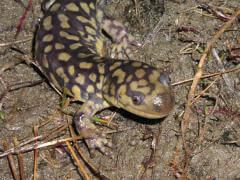This is the third in a three-part series on endangered species. Part 1, which appeared in the June 12 Herald, examined the importance of the Delaware Bay Flyway and the effects pesticides had on eagles, ospreys, peregrine falcons and red knots. Part 2, which appeared in the June 19 Herald, noted what efforts are being taken to protect horseshoe crabs, a vital part of the Cape May County eco-tourism industry.
Before a species lands on a state or federal threatened or endangered list, scientists come together to pool their knowledge and share it with the public, according to Eric Stiles, president and CEO of the New Jersey Audubon Society.
Hearings are held and a species may be considered a “concern, threatened, endangered or extinct” based on scientific data. Since some species live in specific states or regions, there are federal and state-based lists.
The term “Species of Special Concern” applies to species which warrant special attention because of evidence of decline, inherent vulnerability to environmental deterioration, or habitat modification which results in becoming a “threatened” species.
“Endangered” applies to a species whose prospects for survival are in immediate danger due to one or several factors, such as loss or degradation of habitat, over-exploitation, predation (the preying of one animal on others), competition, disease or environmental pollution, etc.
An endangered species likely requires immediate action to avoid extinction.
“Threatened” applies to species that may become “endangered” if conditions surrounding it begin to or continue to deteriorate.
“Stable” (or increasing) applies to species that appear to be secure and not in danger of falling into any of the preceding categories in the near future. “Undetermined” is a species about which there is not enough information available to determine the status.
“Once they are placed on the list, one of the most important things is to create a recovery plan,” Stiles said. “What needs to be done to recover the species? The goal is to get the species off the list.”
However, “a vision without funding is a hallucination,” Stiles pointed out. “Any recovery plan can be undermined if the government removes the funding. That has never happened at the state level.”
Habitat Restoration Funded
After Hurricane Sandy stripped many of the spawning beaches of sand with wind and 11-foot tides, the horseshoe crab could not lay its eggs on the rocks, said Brian Braudis, manager of the Cape May National Wildlife Refuge.
“The whole eco-system up the coast was destroyed, so we had an opportunity to make it stronger,” he continued.
There was a $103-million resiliency fund through the Hurricane Sandy Coastal Resiliency Competitive Grant Program to restore and improve the coastline. Braudis said 73 projects were funded across 14 states; 13 of those projects were in New Jersey for $42 million.
Some of the projects included restoration of marshes in Stone Harbor and Avalon, restoring natural habitats and flood protection.
It also included work on South Reeds, Kimbles and Cooks beaches, where rubble and debris were removed and new sand was added and graded to an appropriate profile for horseshoe crab spawning and migratory shorebird foraging.
In April 2015, an intertidal oyster reef was built as an experimental wave attenuation project, which has since been colonized by hundreds of oysters and other bay species.
“The projects helped restore marshes, the coastline and the eco-system to stop the storm surge and protect homes, and protect the natural habitats of our birds,” Braudis noted.
Some Species Still Recovering
Some species, like the piping plover, are still recovering, according to officials. Piping plovers inhabit oceanfront beaches and barrier islands, typically nesting on the stretch of beach between the dunes and the high-tideline.
Nests are often located in flat areas with shell fragments and sparse vegetation. However, since the late 1940s, coastal development and the elevated recreational use of beaches have caused plover population declines.
In 1984, the piping plover was listed as an “endangered” species in New Jersey. In 1986, the Atlantic Coast piping plover population was listed as “threatened” in the nation.
A recovery goal of 2,000 pairs was set for the Atlantic Coast population, including 575 pairs in the New Jersey and New York region. Active monitoring and management of the birds by the New Jersey Endangered and Nongame Species Program (ENSP) are integral parts of federal recovery efforts.
Since its date of listing, the Atlantic Coast piping plover population has increased, however, the number of plovers nesting in New Jersey has remained essentially stable at around 120 pairs.
Due to its precarious existence, the piping plover remains one of New Jersey’s most endangered species. The threats that it faces, including increased beach recreation and predation, continue to act as serious impediments to the recovery of this species.
Without intense protection and management, it is unlikely that the piping plover would survive in New Jersey.
Another species, the Eastern Tiger Salamander, used to be found across southern New Jersey, according to Kathy Clark, supervisory biologist of endangered and threatened non-game species for the state Division of Fish and Wildlife. Her work covers migratory raptors, bald eagles, osprey and the peregrine falcon, among many others.
Habitat loss and the pollution of breeding ponds led to the decline of tiger salamander populations in New Jersey. By the mid-1970s, the known historic breeding sites had been roughly halved, to 19 sites. Consequently, the Eastern Tiger Salamander was listed as an “endangered” species in New Jersey in 1974.
The New Jersey Natural Heritage Program considers the tiger salamander to be “demonstrably secure globally,” yet “imperiled in New Jersey because of rarity.”
Currently, the status of the tiger salamander population in New Jersey remains endangered. Population stability varies by site.
At many locations, numbers have declined and habitat, particularly on private land, is increasingly threatened by encroaching development. Protected sites, such as those on state land, appear to have stable populations.
The salamanders, who live mostly underground, are only found in Cape May County because they need vernal pools that dry during the summer with a mostly forest habitat surrounding them. Clark said they grow to be 8-10 inches long and can live long lives.
Since Hurricane Sandy, their habitat has shrunk because of saltwater intrusion turning the vernal pools into brackish water, in which they can’t survive, according to Clark. Even the nearest population in eastern Long Island, N.Y. has disappeared.
“Why should we care about any of this?” she asked. “Because it’s a good inclination of how clean our water is, the integrity of our natural habitats, of climate changes.”
How to Help
Biologists and naturalists offered several suggestions.
“Viewing wildlife can be very stressful to the animal,” noted Clark. “When we watch them, we watch them just like their predators do, so they think humans are predators and get stressed. No one wants to cause stress, but we need to be aware of our surroundings.”
Without active protection, these birds could disappear from the beaches, so government agencies and conservation organizations protect beach-nesting birds in a variety of ways.
Biologists locate nesting areas that are then protected with a fence and posted with signs to alert people of the birds’ presence. Individual piping plover nests are sometimes protected with predator “exclosures,” wire cages that help keep predators away from eggs and just-hatched chicks.
Employees and dedicated volunteers patrol the beaches to monitor nesting areas and speak with beachgoers about what they can do to help protect the birds.
Those who ignore signs or enter fenced areas may accidentally step on the camouflaged eggs or chicks. If disturbed, parent birds will leave their nests, exposing eggs or chicks to deadly heat or predators. Exposed eggs or chicks can die in minutes on a hot summer day.
Dogs may chase or harass adults and chicks, sometimes even eating or stepping on chicks and eggs. Prolonged disturbance of young chicks can interrupt their feeding and lead to starvation or increase the likelihood of predation.
“If you see that a beach is closed, respect the sign,” Braudis said. “We don’t have law enforcement, so when you see a beach closed for the birds, respect it. Keep dogs on a leash if you can have animals on the beach. People can be over-zealous when they see a nest, but it requires respect.”
If you see a horseshoe crab on its back, flip it over, Braudis said.
Clark cautions, however, to be aware if shorebirds are feeding on the crab’s eggs before flipping them over. “You could have a negative impact if the birds are feeding unless it’s nighttime. Be aware of your surroundings,” she warned.
Nest observers should stay at least 1,000 feet away so as not to stress the birds, especially eagles. “Ideally, stay in your car, it’s less disturbing,” Clark said.
There are about 100 people who watch nests weekly on behalf of the state Division of Fish and Wildlife, reporting when eagles initiate a nest, lay eggs, hatch, the numbers of eggs and fledglings.
Finally, Clark suggested homeowners grow native plants, which are important for pollinators and migratory birds. “It can help make up for the lost habitats,” she said.
To contact Karen Knight, email kknight@cmcherald.com.








